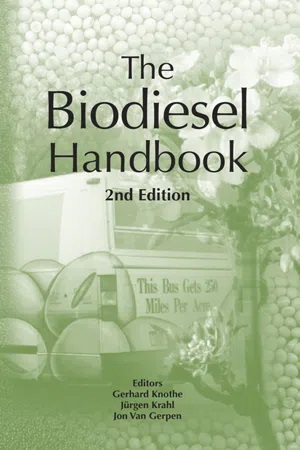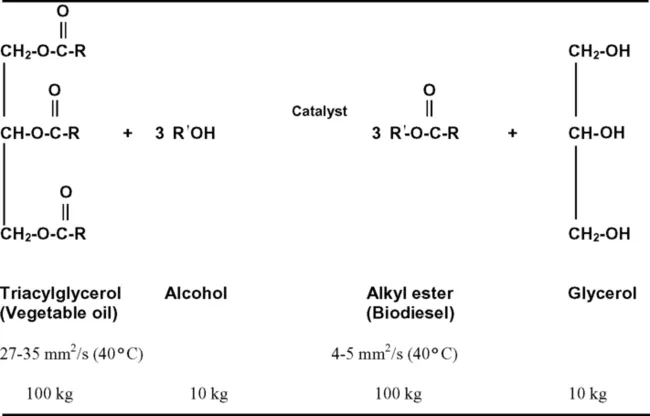
- 494 pages
- English
- ePUB (mobile friendly)
- Available on iOS & Android
eBook - ePub
The Biodiesel Handbook
About this book
The second edition of this invaluable handbook covers converting vegetable oils, animal fats, and used oils into biodiesel fuel. The Biodiesel Handbook delivers solutions to issues associated with biodiesel feedstocks, production issues, quality control, viscosity, stability, applications, emissions, and other environmental impacts, as well as the status of the biodiesel industry worldwide.- Incorporates the major research and other developments in the world of biodiesel in a comprehensive and practical format- Includes reference materials and tables on biodiesel standards, unit conversions, and technical details in four appendices- Presents details on other uses of biodiesel and other alternative diesel fuels from oils and fats
Frequently asked questions
Yes, you can cancel anytime from the Subscription tab in your account settings on the Perlego website. Your subscription will stay active until the end of your current billing period. Learn how to cancel your subscription.
No, books cannot be downloaded as external files, such as PDFs, for use outside of Perlego. However, you can download books within the Perlego app for offline reading on mobile or tablet. Learn more here.
Perlego offers two plans: Essential and Complete
- Essential is ideal for learners and professionals who enjoy exploring a wide range of subjects. Access the Essential Library with 800,000+ trusted titles and best-sellers across business, personal growth, and the humanities. Includes unlimited reading time and Standard Read Aloud voice.
- Complete: Perfect for advanced learners and researchers needing full, unrestricted access. Unlock 1.4M+ books across hundreds of subjects, including academic and specialized titles. The Complete Plan also includes advanced features like Premium Read Aloud and Research Assistant.
We are an online textbook subscription service, where you can get access to an entire online library for less than the price of a single book per month. With over 1 million books across 1000+ topics, we’ve got you covered! Learn more here.
Look out for the read-aloud symbol on your next book to see if you can listen to it. The read-aloud tool reads text aloud for you, highlighting the text as it is being read. You can pause it, speed it up and slow it down. Learn more here.
Yes! You can use the Perlego app on both iOS or Android devices to read anytime, anywhere — even offline. Perfect for commutes or when you’re on the go.
Please note we cannot support devices running on iOS 13 and Android 7 or earlier. Learn more about using the app.
Please note we cannot support devices running on iOS 13 and Android 7 or earlier. Learn more about using the app.
Yes, you can access The Biodiesel Handbook by Gerhard Knothe,Jürgen Krahl,Jon Van Gerpen in PDF and/or ePUB format, as well as other popular books in Technology & Engineering & Industrial & Technical Chemistry. We have over one million books available in our catalogue for you to explore.
Information
Edition
2Subtopic
Industrial & Technical Chemistry1
Introduction
Gerhard Knothe, USDA, ARS, NCAUR, Peoria, IL
What Is Biodiesel?
The major components of vegetable oils and animal fats are triacylglycerols (often also called triglycerides). Chemically, triacylglycerols are esters of fatty acids with glycerol (1,2,3-propanetriol; glycerol is often also called glycerine). The triacylglycerols of vegetable oils and animal fats typically contain several different fatty acids. Thus, different fatty acids can be attached to one glycerol backbone. The different fatty acids that are contained in the triacylglycerols comprise the fatty acid profile (or fatty acid composition) of the vegetable oil or animal fat. As different fatty acids have different physical and chemical properties, the fatty acid profile is probably the most important parameter influencing the properties of a vegetable oil or animal fat.
For obtaining biodiesel, the vegetable oil or animal fat is subjected to a chemical reaction termed transesterification. In that reaction, the vegetable oil or animal fat is reacted in the presence of a catalyst (usually a base) with an alcohol (usually methanol) to give the corresponding alkyl esters (when using methanol, the methyl esters) of the fatty acid mixture that is found in the parent vegetable oil or animal fat. Fig 1.1 depicts the transesterification reaction. While the transesterification reaction formally requires a molar ratio of alcohol to oil of 3:1 as shown in Fig. 1.1, in practice a molar ratio of 6:1 needs to be applied in order for the reaction to proceed properly to high yield. Approximate weights of the reactants in the transesterification process are also given in Fig. 1.1.

Biodiesel can be produced from a great variety of feedstocks. These feedstocks include most common vegetable oils (soybean, cottonseed, palm, peanut, rapeseed /canola, sunflower, safflower, coconut, etc.) and animal fats (usually tallow) as well as waste oils (used frying oils, etc.). Which feedstock is used depends largely on geography. Depending on the origin and quality of the feedstock, changes to the production process may be necessary.
Biodiesel is miscible with petrodiesel in all ratios. This has led to the use of blends of biodiesel with petrodiesel instead of neat biodiesel in many countries. It is important to note that blending with petrodiesel is not biodiesel. Often blends with petrodiesel are denoted by acronyms such as B20 which is a blend of 20% biodiesel with petrodiesel. Of course, the untransesterified vegetable oils and animal fats should also not be termed biodiesel.
Methanol is used as alcohol for producing biodiesel because it is the least expensive alcohol, although other alcohols, for example ethanol or iso-propanol, may afford a biodiesel fuel with better fuel properties. Often the resulting product is also called FAME (fatty acid methyl esters) instead of biodiesel. Although other alcohols can by definition give biodiesel, many now existing standards are designed in such a fashion that only methyl esters can be used as biodiesel when observing the standards.
Biodiesel has several distinct advantages compared to petrodiesel besides being fully competitive with petrodiesel in most technical aspects:
• Derived from a renewable domestic resource, thus reducing dependence on and preserving petroleum.
• Biodegradability.
• Reduces most regulated exhaust emissions (with the exception of nitrogen oxides, NOx).
• Higher flash point leading to safer handling and storage.
• Excellent lubricity. This fact is steadily gaining significance with the advent of low-sulfur petrodiesel fuels, which have significantly reduced lubricity. Adding biodiesel at low levels (1-2%) restores the lubricity.
Some problems associated with biodiesel are its inherent higher price, which in many countries is offset by legislative and regulatory incentives or subsidies in the form of reduced excise taxes, slightly increased NOx exhaust emissions (as mentioned above), stability when exposed to air (oxidative stability), and cold flow properties which are especially relevant in North America. The higher price can also be (partially) offset by the use of less expensive feedstocks which has sparked the interest in materials such as waste oils (for example, used frying oils).
Why are Vegetable Oils and Animal Fats Transesterified to Alkyl Esters (Biodiesel)?
The major reason that vegetable oils and animal fats are transesterified to alkyl esters (biodiesel) is that the kinematic viscosity of the biodiesel is much closer to that of petrodiesel. The high viscosity of untransesterified oils and fats leads to operational problems in the diesel engine such as deposits on various engine parts. While there are engines and burners that can use untransesterified oils, the vast majority of engines require the lower viscosity fuel. Typical kinematic viscosity ranges of vegetable oils and biodiesel (in form of methyl esters) are also shown in Fig. 1.1.
Why Can Vegetable Oils, Animal Fats, and Their Derivatives be Used as (Alternative) Diesel Fuel?
The fact that vegetable oils, animal fats, and their derivatives such as alkyl esters are suitable as diesel fuel demonstrates that there must be some similarity to petrodiesel fuel or, at least, to some of its components. Probably the fuel property that shows this suitability best is the cetane number (see Chapter 6.1).
Besides ignition quality as expressed by the cetane scale, several other properties determine the quality of a biodiesel fuel. Heat of combustion, pour point, cloud point, (kinematic) viscosity, oxidative stability and lubricity are probably the most important of these other properties. Biodiesel standards such as ASTM D6751 in the United States and EN 14214 in Europe contain numerous other specifications, which often relate to production or storage issues, to ensure that biodiesel can be used in a diesel engine.
2
History of Vegetable Oil-Based Diesel Fuels
Gerhard Knothe, USDA, ARS, NCAUR, Peoria, IL
Rudolf Diesel
That vegetable oils and animal fats were investigated as diesel fuels well before the energy crises of the 1970s and early 1980s sparked renewed interest in alternative fuels is generally well known. It is also known that Rudolf Diesel (1858-1913), the inventor of the engine that bears his name, had some interest in these fuels. However, the early history of vegetable oil-based diesel fuels is often presented inconsistently and “facts” that are not compatible with Diesel’s own statements can be frequently encountered.
Therefore it is appropriate to begin this history with the words of Diesel himself in his book Die Entstehung des Dieselmotors (Diesel 1913a; translatable to The Development (or Creation or Rise or Coming) of the Diesel Engine) in which he describes when the first seed of developing what was to become the diesel engine was planted in his mind. On p. 1 (in the first chapter entitled “The Idea” of the book), Diesel states (translated): “When my highly respected teacher, Professor Linde, explained to his listeners during the lecture on thermodynamics in 1878 at the Polytechnikum in Munich (note: now the Technical University of Munich) that the steam engine only converts 6-10% of the available heat content of the fuel into work, when he explained Carnot’s theorem and elaborated that during the isothermal change of state of a gas all transferred heat is converted into work, I wrote in the margin of my notebook: “Study, if it isn’t possible to practically realize the isotherm!” At that time I challenged myself! That was not yet an invention, not even the idea for it. From then on, the desire to realize the ideal Carnot process determined my existence. I left th...
Table of contents
- Cover image
- Title page
- Table of Contents
- Copyright
- Preface to the Second Edition
- Preface to the First Edition
- Contributing Authors
- Chapter 1: Introduction
- Chapter 2: History of Vegetable Oil-Based Diesel Fuels
- Chapter 3: Basics of Diesel Engines and Diesel Fuels
- Chapter 4: Biodiesel Production
- Chapter 5: Analytical Methods
- Chapter 6: Fuel Properties
- Chapter 7: Exhaust Emissions
- Chapter 8: Current Status of the Biodiesel Industry
- Chapter 9: Other Uses of Biodiesel
- Chapter 10: Other Alternative Diesel Fuels from Vegetable Oils and Animal Fats
- Chapter 11: Glycerol Technology Options for Biodiesel Industry
- Appendix A: Technical Tables
- Appendix B: Biodiesel Standards
- Appendix C: Unit Conversions
- Appendix D: Internet Resources
- Index